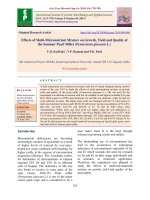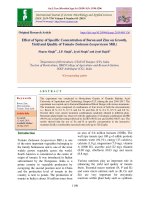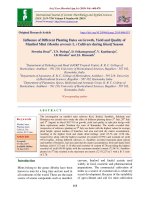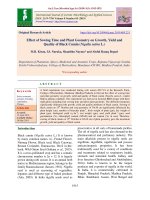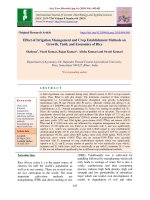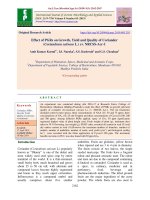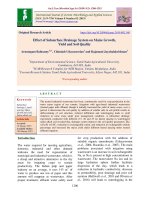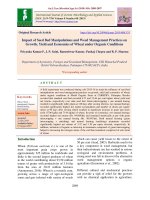Influence of different sources nutrient modules on growth, yield and soil properties of banana cv. Grand Naine
Bạn đang xem bản rút gọn của tài liệu. Xem và tải ngay bản đầy đủ của tài liệu tại đây (335.89 KB, 10 trang )
Int.J.Curr.Microbiol.App.Sci (2018) 7(1): 1985-1994
International Journal of Current Microbiology and Applied Sciences
ISSN: 2319-7706 Volume 7 Number 01 (2018)
Journal homepage:
Original Research Article
/>
Influence of Different Sources Nutrient Modules on Growth, Yield and Soil
Properties of Banana cv. Grand Naine
T. Ganapathi*, P.R. Dharmatti and Ramakrishna V. Hegde
Department of Horticulture, University of Agricultural Sciences, Dharwad-580 005,
Karnataka, India
*Corresponding author
ABSTRACT
Keywords
Banana cv. Grand
Naine, Nutrient
module, INM,
Growth and yield
parameters
Article Info
Accepted:
14 December 2017
Available Online:
10 January 2018
The present study was conducted in the experimental plot at Main Agricultural Research
Station (MARS), College of Agriculture, University of Agricultural Sciences, Dharwad,
Karnataka during 2014-15 and 2015-16 on “Integrated nutrient management studies in
banana cv. Grand Naine (AAA)”. Application of plants with combination of organic
manures + Green manure and Azospirillum was carried out to assess the influence on
growth, yield and soil properties of banana. The results indicated that combined
application of plants with Vermicompost equivalent to 40 % RDN (24.20 t/ha) + 40 %
RDN through chemical fertilizer (Urea 535.73 kg/ ha) + Green manure (sunnhemp @ 8.88
t/ha) and Azospirillum (30.86 kg/ha) equivalent to 20 % RDN + PSB (30.86 kg/ha) (T7)
recorded the highest growth parameters [pseudostem height (205.05cm), pseudostem girth
(27.47cm), number of leaves (16.00), leaf area (8.87m2), the least number of days taken for
shooting (190.65) and total crop duration (318.89)], yield parameters {bunch weight
(26.94 kg), number of hands per bunch (11.75), finger weight (137.38 g), finger length
(17.75 cm) and the yield per ha (66.02 t)] followed by T10 and T11 treatments. After the
completion of the experiment the organic carbon was found to increase in organic
treatments (T1 to T5) from 0.65 % to 0.72 %, whereas it was decreased from 0.65 % to 0.57
% in integrated treatments (T6 to T12). The available N in soil was significantly higher in
organic treatments than integrated treatments. The available phosphorous was decreased in
organic treatments compared to integrated treatments. The available potash recorded
higher status in organic treatments compared to integrated treatments.
Introduction
In India, banana is cultivated in an area of
0.83 million ha with a production of 30
million tonnes (Anon., 2011). The major
banana growing areas are in Tamil Nadu,
Maharashtra, Andhra Pradesh, Gujarat,
Kerala, Karnataka, West Bengal and Orissa. It
is being grown in an area of 1.12 lakh ha with
a production of 2.28 lakh tonnes in Karnataka
state. Banana is known to consume more
nutrients for its growth, yield and biomass
production (Hazarika et al., 2015). The use of
chemical fertilizers alone has deleterious
effect on soil physical, chemical and
biological properties and productivity in the
long run. The availability of organic manures
is also one of the limitations for use in banana
1985
Int.J.Curr.Microbiol.App.Sci (2018) 7(1): 1985-1994
production. To fulfil the nutrient requirement
only through organic or inorganic or biofertilizers alone is seldom possible but
integration of all these sources will not only
aid in achieving higher yields but also in
sustaining the soil fertility status in the long
run.
Materials and Methods
The field experiment with an integrated
nutrient module consisting of organic
manures, chemical fertilizers, green manure
and bio-fertilizer in banana cv. Grand Naine
was conducted during 2014-15 and 2015-16 at
new orchard, Department of Horticulture,
University of Agricultural Sciences, Dharwad.
The soil type was red with clay texture. The
experiment consists of 12 treatments viz.
Plant crop
T1 - FYM equivalent to 40 % RDN (48.40
t/ha) + VC equivalent to 40 % RDN (24.20
t/ha) + GM (Sunnhemp @ 8.88 t/ha) and
Azospirillum (30.86 kg/ha) equivalent to 20 %
RDN + PSB (30.86 kg/ha).
T2 – FYM equivalent to 40 % RDN (48.40
t/ha) + PM equivalent to 40 % RDN (8.96
t/ha) + GM (Sunnhemp @ 8.88 t/ha) and
Azospirillum (30.86 kg/ha) equivalent to 20 %
RDN + PSB (30.86 kg/ha).
T3 - FYM equivalent to 40 % RDN (48.40
t/ha) + SM equivalent to 40 % RDN (10.17
t/ha) + GM (Sunnhemp @ 8.88 t/ha) and
Azospirillum (30.86 kg/ha) equivalent to 20 %
RDN + PSB (30.86 kg/ha).
T4 - FYM equivalent to 40 % RDN (48.40
t/ha) + AG equivalent to 40 % RDN (10.52
t/ha) + GM (Sunnhemp @ 8.88 t/ha) and
Azospirillum (30.86 kg/ha) equivalent to 20 %
RDN + PSB (30.86 kg/ha).
T5 - FYM equivalent to 40 % RDN (48.40
t/ha) + BL equivalent to 40 % RDN (7.56 t/ha)
+ GM (Sunnhemp @ 8.88 t/ha) and
Azospirillum (30.86 kg/ha) equivalent to 20 %
RDN + PSB (30.86 kg/ha).
T6 - FYM equivalent to 40 % RDN (48.40
t/ha) + 40 % RDN through chemical fertilizer
(Urea 535.73 kg/ ha) + GM (Sunnhemp @
8.88 t/ha) and Azospirillum (30.86 kg/ha)
equivalent to 20% RDN + PSB (30.86 kg/ha).
T7 - VC equivalent to 40 % RDN (24.20 t/ha)
+ 40 % RDN through chemical fertilizer (Urea
535.73 kg/ ha) + GM (Sunnhemp @ 8.88 t/ha)
and Azospirillum (30.86 kg/ha) equivalent to
20 % RDN + PSB (30.86 kg/ha).
T8 - PM equivalent to 40 % RDN (8.96 t/ha) +
40 % RDN through chemical fertilizer (Urea
535.73 kg/ ha) + GM (Sunnhemp @ 8.88 t/ha)
and Azospirillum (30.86 kg/ha) equivalent to
20 % RDN + PSB (30.86 kg/ha).
T9 - SM equivalent to 40 % RDN (10.17 t/ha)
+ 40 % RDN through chemical fertilizer (Urea
535.73 kg/ ha) + GM (Sunnhemp @ 8.88 t/ha)
and Azospirillum (30.86 kg/ha) equivalent to
20 % RDN + PSB (30.86 kg/ha).
T10 - AG equivalent to 40 % RDN (10.52 t/ha)
+ 40 % RDN through chemical fertilizer (Urea
535.73 kg/ ha) + GM (Sunnhemp @ 8.88 t/ha)
and Azospirillum (30.86 kg/ha) equivalent to
20 % RDN + PSB (30.86 kg/ha)
T11 - BL equivalent to 40 % RDN (7.56 t/ha) +
40 % RDN through chemical fertilizer (Urea
535.73 kg/ ha) + GM (Sunnhemp @ 8.88 t/ha)
and Azospirillum (30.86 kg/ha) equivalent to
20 % RDN + PSB (30.86 kg/ha)
T12 - Control (RDF 200: 100: 300 g NPK
/plant or 617.20:308.60: 925.80 kg NPK/ha +
Farm yard manure@ 40 t/ha)
1986
Int.J.Curr.Microbiol.App.Sci (2018) 7(1): 1985-1994
The recommended dose of phosphorous and
potash (100 g/plant and 300 g/plant
respectively) was supplied through DAP and
MOP.
Ratoon crop
RDF = 100:50:100 NPK g /plant or
308.60:154.20: 308.60 kg NPK/ha) + FYM @
20 t/ha
The recommended dose of phosphorous and
potash (50 g / plant and 100 g / plant
respectively) was supplied through DAP and
MOP. Note: 1) FYM- Farm Yard Manure,
VC-Vermicompost, PM-Poultry Manure, SMSheep Manure, AG-Agrigold, BL-Bhumilabh,
GM-Green
manure,
PSB-Phosphate
Solubilizing bacteria. Azospirillum (ACD-15)
and PSB (Pseudomonas striata) were used for
the study.
The application of organic manures, chemical
fertilizers with green manure and bio-fertilizer
will compensate the majority of the plant
nutrition
thereby increase
the
crop
productivity of banana cv. Grand Naine. The
influence was assessed on growth, yield and
available NPK in the soil. The results of
pooled mean of the field experiment
conducted during the year 2014-15 and 201516 are discussed.
Results and Discussion
The results of pooled mean of the field
experiments conducted during the year 201415 and 2015-16 are discussed under different
headings.
Influence of integrated nutrient modules on
growth parameters of banana (Table 1 and
2)
The yield attributing parameters are in turn
dependent on growth parameters of banana.
The influence of different integrated nutrient
modules on growth parameters which caused
the yield variations are discussed here under.
The pooled mean results indicated that at
shooting the highest plant height (205.05 cm)
was recorded in T7 {Vermicompost equivalent
to 40 % RDN (24.20 t/ha) + RDN 40 %
through fertilizer + Green manure (sunnhemp
@ 8.88 tons/ha) and Azospirillum (30.86
kg/ha) equivalent to 20 % RDN + PSB (30.86
kg/ha)} which was on par with T6, T10 and T11
and significantly superior over rest of the
treatments. The least pseudostem height was
recorded in T8 (171.53 cm). The pseudostem
girth was significantly higher with T7
treatment (27.47 cm) followed by T9 which
was on par with T1, T4, T5, T6, T9, T10, T11 and
T12.
The highest number of leaves (16.00) was
recorded in T7 {Vermicompost equivalent to
40 % of RDN (24.20 t/ha) + RDN 40 %
through fertilizer + Green manure (sunnhemp
@ 8.88 tons/ha) and Azospirillum (30.86
kg/ha) equivalent to 20 % RDN + PSB (30.86
kg/ha)} indicating the superiority of integrated
nutrient module over organic treatments alone.
The application vermicompost equivalent to
40 % RDN (24.20 t/ha) + RDN 40 % through
fertilizer + Green manure (sunnhemp @ 8.88
tons/ha) + Azospirillum (30.86 kg/ha)
equivalent to 20 % RDN + PSB (30.86 kg/ha)
(T7) recorded significantly higher leaf area
(8.87 m2) followed by T1, T4, T5, T9, T10 and
T11. The pooled data indicated that, the highest
leaf area index (2.74) at shooting was recorded
in T7 which was on par with T1, T4, T5, T9, T10
and T11 treatments having integrated nutrient
modules and superior over rest of the
treatments.
The mean least number of days taken for
shooting, shooting to harvest and total crop
duration (190.65, 128.24 and 318.89 days
1987
Int.J.Curr.Microbiol.App.Sci (2018) 7(1): 1985-1994
respectively)
was
recorded
in
T7
{Vermicompost equivalent to 40 % RDN
(24.20 t/ha) + 40 % RDN through fertilizer +
Green manure (sunnhemp @ 8.87 t/ha) and
Azospirillum (30.86 kg/ha) equivalent to 20 %
RDN + PSB (30.86 kg/ha). The results
indicated that, the integrated nutrient modules
T7 (with Vermicompost combination), T10
(with Agrigold combination) and T11 (with
Bhumilabh combination) were recorded lesser
days taken for shooting, shooting harvest and
total crop duration indicating the potentiality
of these organic manures along with chemical
and bio-fertilizers.
The similar results were also obtained by
several workers. Jayabaskaran et al., (2001)
observed significantly higher plant height in
Poovan banana by application of poultry
manure at 15 kg per plant and followed by
application of rice husk ash @ 15 kg per plant.
Nachegowda et al., (2004) recorded that the
plants applied with 180:108:220 g of NPK +
15 kg of FYM were recorded the highest plant
height followed by banana plants supplied
with 2.5 kg sheep manure + 180:108:220 g
NPK/plant/year. Patil and Shinde (2013) also
reported that, treatment with 50 % RDF +
FYM (10 kg/plant) + Azotobacter (50 g/Plant)
+ PSB (50 g/plant) + VAM (250 g/plant)
recorded significantly the highest number of
leaves at different DAP and at shooting stage.
The integrated nutrient module particularly T7
(Vermicompost combination), followed by T10
(Agri-gold combination) and T11 (Bhumilabh
combination) were found to be most
promising in obtaining higher growth
parameters of banana.
Influence of integrated nutrient modules on
banana yield parameters (Table 3)
The pooled data indicated that, the maximum
mean yield of banana per hectare (66.02 t/ha)
was also recorded in T7 {Vermicompost
equivalent to 40 % RDN (24.20 t/ha) + 40 %
RDN through chemical fertilizer (Urea 535.73
kg/ ha) + Green manure (Sunnhemp @ 8.88
t/ha) + Azospirillum (30.86 kg/ha) equivalent
to 20 % RDN + PSB (30.86 kg/ha)}which was
on par with T1, T10 and T11 significantly
superior over rest of the treatments (Table 3).
The highest mean yield of banana in T7 was
attributed to the higher growth and yield
contributing parameters in the same treatment.
The mean yield components of banana
indicated that the maximum bunch weight
(26.94 kg), number of hands per bunch
(11.75), finger weight (137.38 g), finger
length (17.75 cm), number of fingers on third
hand (16.93) were recorded in plants applied
with vermicompost equivalent to 40 % RDN
(24.20 t/ha) + 40 % RDN through urea +
Green manure (sunnhemp @ 8.88 t/ha) and
Azospirillum (30.86 kg/ha) equivalent to 20 %
RDN + PSB (30.86 kg/ha) (T7).
The similar results were also recorded with
integrated nutrient modules by many scientists
in banana.
Athani et al., (1999) reported that, maximum
number of fingers per bunch, bunch weight
(5.10 kg/bunch) and finally fruit yield (15.14
t/ha) was obtained by applying 50 % RDF +
vermicompost 2.00 kg/plant in Rajapuri
banana.
They also reported that, organic matter in the
form of vermicompost in combination with
inorganic fertilizers increased the yield in
banana cv. Rajapuri. Nachegowda et al.,
(2004) reported that, plants applied with 15 kg
FYM + 180:108:220g NPK /plant/year
recorded the highest bunch weight (49.47 kg),
fruit length (25.19 cm), fruit weight (220.21
g), finger /hand (19.00), fingers/bunch
(227.94) and the yield (148.41t/ha) in banana
followed by 2.5 kg Sheep manure +
108:108:2205g NPK /plant/year.
1988
Int.J.Curr.Microbiol.App.Sci (2018) 7(1): 1985-1994
Table.1 Influence of different sources of nutrient modules on growth parameters in banana cv. Grand Naine (Pooled mean)
Treatments
Pseudostem height (cm)
70
105
140
DAP
DAP
DAP
69.63
106.09 139.27
At
shooting
189.33
35
DAP
7.75
Pseudostem girth (cm)
70
105
140
At
DAP
DAP
DAP
shooting
10.57 13.40 17.52
27.12
35
DAP
7.16
Number of leaves
70
105
140
DAP
DAP
DAP
11.44 11.78 11.79
T1
35
DAP
40.13
At
shooting
15.35
T2
35.08
66.93
102.84
136.71
183.31
6.46
10.12
13.04
16.86
25.25
6.70
11.37
11.81
11.32
15.03
T3
32.78
66.64
101.61
136.20
181.39
6.75
9.68
12.93
16.77
25.62
6.50
10.76
11.29
10.84
14.36
T4
38.47
69.83
104.38
137.78
186.27
7.33
10.35
13.31
17.42
26.62
6.01
11.26
11.71
11.46
15.18
T5
38.27
67.86
104.77
137.36
185.62
7.23
10.39
13.37
17.07
26.01
7.02
11.44
11.71
11.46
15.27
T6
41.05
72.03
109.24
140.95
194.26
8.15
11.28
14.11
17.79
27.25
8.25
11.86
11.83
11.83
15.68
T7
51.96
83.65
117.54
146.97
205.05
9.26
11.97
14.85
18.16
27.47
9.37
12.42
12.33
11.90
16.00
T8
30.32
65.45
99.77
128.15
171.53
6.65
9.56
12.72
16.14
24.99
5.64
10.01
10.41
10.00
13.24
T9
40.33
71.32
106.32
139.02
190.44
7.95
11.03
13.43
17.60
27.26
8.06
11.64
11.76
11.39
15.53
T10
46.75
79.32
116.31
146.49
203.25
8.76
11.83
14.81
17.81
26.85
8.62
12.25
12.27
11.87
15.80
T11
42.53
75.04
109.36
142.29
196.96
8.62
11.60
14.30
17.80
26.77
8.35
11.96
12.07
11.61
15.45
T12
40.94
71.52
106.55
139.57
191.92
7.71
10.67
13.57
17.79
26.75
8.09
11.71
11.75
11.69
15.26
SEm+/CD at 5%
4.75
13.93
4.72
13.85
3.42
10.04
3.57
10.48
4.16
12.20
0.71
2.08
0.47
1.39
0.60
1.76
0.51
1.49
0.43
1.27
0.22
0.65
0.38
1.12
0.34
1.01
0.36
1.05
0.51
1.51
DAP: Days after planting
T1- FYM equivalent to 40 % RDN (48.40 t/ha) + VC equivalent to 40 % RDN (24.20 t/ha) + GM (sunnhemp @ 8.88 t/ha) and Azospirillum (@ 30.86 kg/ha) equivalent to 20 % RDN + PSB (@ 30.86 kg/ha).
T2-FYM equivalent to 40 % RDN (48.40 t/ha) + PM equivalent to 40 % RDN (8.96 t/ha) + GM (sunnhemp @ 8.88 t/ha) and Azospirillum (@ 30.86 kg/ha) equivalent to 20 % RDN + PSB (@ 30.86 kg/ha).
T3- FYM equivalent to 40 % RDN (48.40 t/ha) + SM equivalent to 40 % RDN (10.17 t/ha) + GM (sunnhemp @ 8.88 t/ha) and Azospirillum (@ 30.86 kg/ha) equivalent to 20 % RDN + PSB (@ 30.86 kg/ha).
T4- FYM equivalent to 40 % RDN (48.40 t/ha) + AG equivalent to 40 % RDN (10.52 t/ha) + GM (sunnhemp @ 8.88 t/ha) and Azospirillum (@ 30.86 kg/ha) equivalent to 20 % RDN + PSB (@ 30.86 kg/ha).
T5- FYM equivalent to 40 % RDN (48.40 t/ha) + BL equivalent to 40 % RDN (7.56 t/ha) + GM (Sunnhemp @ 8.88 t/ha) and Azospirillum (@ 30.86 kg/ha) equivalent to 20 % RDN + PSB (@ 30.86 kg/ha).
T6 FYM equivalent to 40 % RDN (48.40 t/ha) + 40 % RDN through chemical fertilizer (urea 535.73 kg/ ha) + GM (sunnhemp @8.88 t/ha) and Azospirillum (@ 30.86 kg/ha) equivalent to 20 % RDN + PSB (@
30.86 kg/ha).
T7- VC equivalent to 40 % RDN (24.20 t/ha) + 40 % RDN through chemical fertilizer (urea 535.73 kg/ ha) + GM (sunnhemp@ 8.88 t/ha) and Azospirillum (@ 30.86 kg/ha) equivalent to 20 % RDN + PSB (@ 30.86
kg/ha).
T8- PM equivalent to 40 % RDN (8.96 t/ha) + 40 % RDN through chemical fertilizer (urea 535.73 kg/ ha) + GM (sunnhemp @8.88 t/ha) and Azospirillum (@ 30.86 kg/ha) equivalent to 20 % RDN + PSB (@ 30.86
kg/ha).
T9- SM equivalent to 40 % RDN (10.17 t/ha) + 40 % RDN through chemical fertilizer (urea 535.73 kg/ ha) + GM (sunnhemp @8.88 t/ha) and Azospirillum (@ 30.86 kg/ha) equivalent to 20 % RDN + PSB (@ 30.86
kg/ha).
T10- AG equivalent to 40 % RDN (10.52 t/ha) + 40 % RDN through chemical fertilizer (urea 535.73 kg/ ha) + GM (sunnhemp @8.88 t/ha) and Azospirillum (@ 30.86 kg/ha) equivalent to 20 % RDN + PSB (@ 30.86
kg/ha
T11- BL equivalent to 40 % RDN (7.56 t/ha) + 40 % RDN through chemical fertilizer (urea 535.73 kg/ ha) + GM (sunnhemp @8.88 t/ha) and Azospirillum (@ 30.86 kg/ha) equivalent to 20 % RDN + PSB (@ 30.86
kg/ha)
T12 -Control (RDF=617.20:308.60: 925.80 kg NPK/ha + Farm yard manure@ 40 t/ha (plant crop)
Ratoon crop: RDF=308.60:154.20: 308.60 kg NPK/ha) + FYM @ 20/ha accordingly it has been supplied through different sources
FYM- Farmyard manure, VC-Vermicompost, PM-Poultry manure, SM-Sheep manure, AG-Agrigold, BL-Bhumilabh, GM-Green manure, PSB-Phosphate Solubilizing bacteria
1989
Int.J.Curr.Microbiol.App.Sci (2018) 7(1): 1985-1994
Table.2 Influence of different sources of nutrient modules on growth parameters in banana cv. Grand Naine (Pooled mean)
Treatments
Leaf area (m2)
105
140
DAP
DAP
T1
1.09
2.35
3.01
3.32
7.52
0.34
0.72
0.93
1.25
2.32
215.24
Days
Shooting
to
harvest
133.88
T2
0.96
2.31
2.39
3.17
6.30
0.30
0.71
0.74
1.02
1.94
226.91
138.08
364.99
T3
0.90
2.07
2.38
3.83
6.03
0.28
0.64
0.73
0.98
1.86
229.15
138.41
367.56
T4
0.77
2.27
2.85
3.72
7.25
0.24
0.70
0.88
1.18
2.24
220.96
134.95
355.91
T5
1.05
2.33
2.85
3.53
7.09
0.32
0.72
0.88
1.15
2.19
226.42
136.89
363.30
T6
1.45
2.52
3.12
4.58
6.69
0.45
0.78
0.96
1.09
2.07
204.46
135.50
339.96
T7
1.89
2.82
3.65
2.81
8.87
0.58
0.87
1.13
1.41
2.74
190.65
128.24
318.89
T8
0.68
1.83
2.13
3.87
5.30
0.21
0.57
0.66
0.87
1.63
230.66
138.50
369.16
T9
1.39
2.41
3.01
4.44
7.66
0.43
0.74
0.93
1.19
2.36
211.41
132.39
343.80
T10
1.58
2.75
3.50
4.41
8.57
0.49
0.85
1.08
1.37
2.64
195.25
128.26
323.51
T11
1.49
2.55
3.39
3.66
8.39
0.46
0.79
1.05
1.36
2.59
201.09
129.16
330.24
T12
1.40
2.44
3.15
3.32
6.83
0.43
0.75
0.97
1.13
2.11
206.93
131.67
338.59
S Em+/CD at 5%
0.08
0.24
0.16
0.46
0.29
0.85
0.33
0.96
0.63
1.86
0.02
0.07
0.05
0.14
0.09
0.26
0.10
0.30
0.20
0.57
0.80
2.36
0.55
1.62
1.21
3.55
35
DAP
70
DAP
At
shooting
35
DAP
Leaf area Index
70
105
140
DAP
DAP
DAP
At
shooting
Taken for
shooting
Total
crop
duration
339.12
DAP: Days after planting
T1- FYM equivalent to 40 % RDN (48.40 t/ha) + VC equivalent to 40 % RDN (24.20 t/ha) + GM (sunnhemp @ 8.88 t/ha) and Azospirillum (@ 30.86 kg/ha) equivalent to 20 % RDN + PSB (@ 30.86 kg/ha).
T2-FYM equivalent to 40 % RDN (48.40 t/ha) + PM equivalent to 40 % RDN (8.96 t/ha) + GM (sunnhemp @ 8.88 t/ha) and Azospirillum (@ 30.86 kg/ha) equivalent to 20 % RDN + PSB (@ 30.86 kg/ha).
T3- FYM equivalent to 40 % RDN (48.40 t/ha) + SM equivalent to 40 % RDN (10.17 t/ha) + GM (sunnhemp @ 8.88 t/ha) and Azospirillum (@ 30.86 kg/ha) equivalent to 20 % RDN + PSB (@ 30.86 kg/ha).
T4- FYM equivalent to 40 % RDN (48.40 t/ha) + AG equivalent to 40 % RDN (10.52 t/ha) + GM (sunnhemp @ 8.88 t/ha) and Azospirillum (@ 30.86 kg/ha) equivalent to 20 % RDN + PSB (@ 30.86 kg/ha).
T5- FYM equivalent to 40 % RDN (48.40 t/ha) + BL equivalent to 40 % RDN (7.56 t/ha) + GM (Sunnhemp @ 8.88 t/ha) and Azospirillum (@ 30.86 kg/ha) equivalent to 20 % RDN + PSB (@ 30.86 kg/ha).
T6 FYM equivalent to 40 % RDN (48.40 t/ha) + 40 % RDN through chemical fertilizer (urea 535.73 kg/ ha) + GM (sunnhemp @8.88 t/ha) and Azospirillum (@ 30.86 kg/ha) equivalent to 20 % RDN + PSB (@ 30.86 kg/ha).
T7- VC equivalent to 40 % RDN (24.20 t/ha) + 40 % RDN through chemical fertilizer (urea 535.73 kg/ ha) + GM (sunnhemp@ 8.88 t/ha) and Azospirillum (@ 30.86 kg/ha) equivalent to 20 % RDN + PSB (@ 30.86 kg/ha).
T8- PM equivalent to 40 % RDN (8.96 t/ha)+ 40 % RDN through chemical fertilizer (urea 535.73 kg/ ha) + GM (sunnhemp @8.88 t/ha) and Azospirillum (@ 30.86 kg/ha) equivalent to 20 % RDN + PSB (@ 30.86 kg/ha).
T9- SM equivalent to 40 % RDN (10.17 t/ha) + 40 % RDN through chemical fertilizer (urea 535.73 kg/ ha) + GM (sunnhemp @8.88 t/ha) and Azospirillum (@ 30.86 kg/ha) equivalent to 20 % RDN + PSB (@ 30.86 kg/ha).
T10- AG equivalent to 40 % RDN (10.52 t/ha) + 40 % RDN through chemical fertilizer (urea 535.73 kg/ ha) + GM (sunnhemp @8.88 t/ha) and Azospirillum (@ 30.86 kg/ha) equivalent to 20 % RDN + PSB (@ 30.86 kg/ha
T11- BL equivalent to 40 % RDN (7.56 t/ha) + 40 % RDN through chemical fertilizer (urea 535.73 kg/ ha) + GM (sunnhemp @8.88 t/ha) and Azospirillum (@ 30.86 kg/ha) equivalent to 20 % RDN + PSB (@ 30.86 kg/ha)
T12 -Control (RDF=617.20:308.60: 925.80 kg NPK/ha + Farm yard manure@ 40 t/ha (plant crop)
Ratoon crop: RDF=308.60:154.20: 308.60 kg NPK/ha) + FYM @ 20/ha accordingly it has been supplied through different sources
FYM- Farmyard manure, VC-Vermicompost, PM-Poultry manure, SM-Sheep manure, AG-Agrigold, BL-Bhumilabh, GM-Green manure, PSB-Phosphate Solubilizing bacteria
1990
Int.J.Curr.Microbiol.App.Sci (2018) 7(1): 1985-1994
Table.3 Influence of different sources of nutrient modules on yield parameters in banana cv. Grand Naine (Pooled mean)
Treatments
T1
T2
T3
T4
T5
T6
T7
T8
T9
T10
T11
T12
S Em+/CD at 5%
Bunch weight.
(kg)
18.17
14.58
11.55
17.85
16.41
19.18
26.94
12.85
19.54
23.69
22.51
19.17
0.65
1.91
No. of hands
per bunch
10.06
9.10
8.58
10.31
9.73
10.02
11.75
9.54
10.19
10.98
10.49
9.70
0.15
0.44
Finger weight.
(g)
124.27
117.77
104.28
123.43
120.39
129.53
137.38
104.43
129.83
135.91
135.16
128.02
1.84
5.39
Finger length
(cm)
16.14
15.23
14.36
15.32
15.55
16.12
17.75
14.40
16.12
17.18
17.07
16.66
0.31
0.90
No. of Fingers on
3rd hand
14.89
13.88
13.10
14.26
14.19
15.02
16.93
13.09
15.04
16.12
16.14
15.68
0.30
0.87
Plot yield (kg)
Yield (t/ha)
73.21
60.44
58.35
72.72
70.04
70.52
85.57
61.69
70.83
84.27
73.66
71.21
4.28
12.55
56.48
46.63
45.02
56.10
54.04
54.40
66.02
47.59
54.64
65.01
56.83
54.94
3.30
9.68
T1- FYM equivalent to 40 % RDN (48.40 t/ha) + VC equivalent to 40 % RDN (24.20 t/ha) + GM (sunnhemp @ 8.88 t/ha) and Azospirillum (@ 30.86 kg/ha) equivalent to 20 % RDN + PSB (@ 30.86
kg/ha).
T2-FYM equivalent to 40 % RDN (48.40 t/ha) + PM equivalent to 40 % RDN (8.96 t/ha) + GM (sunnhemp @ 8.88 t/ha) and Azospirillum (@ 30.86 kg/ha) equivalent to 20 % RDN + PSB (@ 30.86
kg/ha).
T3- FYM equivalent to 40 % RDN (48.40 t/ha) + SM equivalent to 40 % RDN (10.17 t/ha) + GM (sunnhemp @ 8.88 t/ha) and Azospirillum (@ 30.86 kg/ha) equivalent to 20 % RDN + PSB (@ 30.86
kg/ha).
T4- FYM equivalent to 40 % RDN (48.40 t/ha) + AG equivalent to 40 % RDN (10.52 t/ha) + GM (sunnhemp @ 8.88 t/ha) and Azospirillum (@ 30.86 kg/ha) equivalent to 20 % RDN + PSB (@ 30.86
kg/ha).
T5- FYM equivalent to 40 % RDN (48.40 t/ha) + BL equivalent to 40 % RDN (7.56 t/ha) + GM (Sunnhemp @ 8.88 t/ha) and Azospirillum (@ 30.86 kg/ha) equivalent to 20 % RDN + PSB (@ 30.86
kg/ha).
T6 FYM equivalent to 40 % RDN (48.40 t/ha) + 40 % RDN through chemical fertilizer (urea 535.73 kg/ ha) + GM (sunnhemp @8.88 t/ha) and Azospirillum (@ 30.86 kg/ha) equivalent to 20 % RDN +
PSB (@ 30.86 kg/ha).
T7- VC equivalent to 40 % RDN (24.20 t/ha) + 40 % RDN through chemical fertilizer (urea 535.73 kg/ ha) + GM (sunnhemp@ 8.88 t/ha) and Azospirillum (@ 30.86 kg/ha) equivalent to 20 % RDN +
PSB (@ 30.86 kg/ha).
T8- PM equivalent to 40 % RDN (8.96 t/ha) + 40 % RDN through chemical fertilizer (urea 535.73 kg/ ha) + GM (sunnhemp @8.88 t/ha) and Azospirillum (@ 30.86 kg/ha) equivalent to 20 % RDN +
PSB (@ 30.86 kg/ha).
T9- SM equivalent to 40 % RDN (10.17 t/ha) + 40 % RDN through chemical fertilizer (urea 535.73 kg/ ha) + GM (sunnhemp @8.88 t/ha) and Azospirillum (@ 30.86 kg/ha) equivalent to 20 % RDN +
PSB (@ 30.86 kg/ha).
T10- AG equivalent to 40 % RDN (10.52 t/ha) + 40 % RDN through chemical fertilizer (urea 535.73 kg/ ha) + GM (sunnhemp @8.88 t/ha) and Azospirillum (@ 30.86 kg/ha) equivalent to 20 % RDN +
PSB (@ 30.86 kg/ha
T11- BL equivalent to 40 % RDN (7.56 t/ha) + 40 % RDN through chemical fertilizer (urea 535.73 kg/ ha) + GM (sunnhemp @8.88 t/ha) and Azospirillum (@ 30.86 kg/ha) equivalent to 20 % RDN +
PSB (@ 30.86 kg/ha)
T12 -Control (RDF=617.20:308.60: 925.80 kg NPK/ha + Farm yard manure@ 40 t/ha (plant crop)
Ratoon crop: RDF=308.60:154.20: 308.60 kg NPK/ha) + FYM @ 20/ha accordingly it has been supplied through different sources
FYM- Farmyard manure, VC-Vermicompost, PM-Poultry manure, SM-Sheep manure, AG-Agrigold, BL-Bhumilabh, GM-Green manure, PSB-Phosphate Solubilizing bacteria
1991
Int.J.Curr.Microbiol.App.Sci (2018) 7(1): 1985-1994
Table.4 Influence of different sources of nutrient modules on soil characteristics in banana cv. Grand Naine (Pooled mean)
Treatments
Soil pH (1:2.5)
EC (dS/m)
Organic C (%)
Avail N (kg/ha)
T1
T2
T3
T4
T5
T6
T7
T8
T9
T10
T11
T12
S Em+/CD at 5%
7.24
7.27
7.34
7.16
6.98
6.93
6.91
7.37
7.07
7.04
7.20
7.11
0.02
0.06
0.14
0.11
0.12
0.12
0.16
0.11
0.11
0.10
0.14
0.12
0.11
0.16
0.01
0.02
0.72
0.68
0.69
0.70
0.71
0.57
0.59
0.58
0.59
0.61
0.59
0.63
0.01
0.01
319.95
302.95
306.68
311.25
314.98
264.48
271.53
268.20
271.10
281.88
271.93
285.18
1.73
5.08
Avail P2O5
(kg/ha)
24.05
22.50
23.90
21.55
23.90
28.20
30.70
26.30
28.20
29.30
28.80
30.70
0.80
2.36
Avail K2O (kg/ha)
133.50
118.80
118.65
133.35
132.90
118.90
130.85
125.80
118.60
123.65
130.85
130.40
0.68
2.00
T1- FYM equivalent to 40% RDN (48.40 t/ha) + VC equivalent to 40% RDN (24.20 t/ha) + GM (sunnhemp @ 8.88 t/ha) and Azospirillum (@ 30.86 kg/ha) equivalent to 20% RDN + PSB (@ 30.86
kg/ha).
T2-FYM equivalent to 40% RDN (48.40 t/ha) + PM equivalent to 40% RDN (8.96 t/ha) + GM (sunnhemp @ 8.88 t/ha) and Azospirillum (@ 30.86 kg/ha) equivalent to 20% RDN + PSB (@ 30.86
kg/ha).
T3- FYM equivalent to 40% RDN (48.40 t/ha) + SM equivalent to 40% RDN (10.17 t/ha) + GM (sunnhemp @ 8.88 t/ha) and Azospirillum (@ 30.86 kg/ha) equivalent to 20% RDN + PSB (@ 30.86
kg/ha).
T4- FYM equivalent to 40% RDN (48.40 t/ha) + AG equivalent to 40% RDN (10.52 t/ha) + GM (sunnhemp @ 8.88 t/ha) and Azospirillum (@30.86kg/ha) equivalent to 20% RDN + PSB (@
30.86kg/ha).
T5- FYM equivalent to 40% RDN (48.40 t/ha) + BL equivalent to 40% RDN (7.56 t/ha) + GM (Sun hemp @ 8.88 t/ha) and Azospirillum (@ 30.86kg/ha) equivalent to 20% RDN + PSB (@ 30.86kg/ha).
T6 FYM equivalent to 40% RDN (48.40 t/ha) + 40% RDN through chemical fertilizer (Urea 535.73 kg/ ha) + GM (sunnhemp @8.88 t/ha) and Azospirillum (@ 30.86 kg/ha) equivalent to 20% RDN +
PSB (@ 30.86kg/ha).
T7- VC equivalent to 40% RDN (24.20 t/ha) + 40% RDN through chemical fertilizer (Urea 535.73 kg/ ha) + GM (sunnhemp@ 8.88 t/ha) + Azospirillum (@ 30.86kg/ha) equivalent to 20% RDN + PSB
(@ 30.86kg/ha).
T8- PM equivalent to 40% RDN (8.96 t/ha)+ 40% RDN through chemical fertilizer (Urea 535.73 kg/ ha) + GM (sunnhemp @8.88 t/ha) and Azospirillum (@ 30.86 kg/ha) equivalent to 20% RDN + PSB
(@ 30.86 kg/ha).
T9- SM equivalent to 40% RDN (10.17 t/ha) + 40% RDN through chemical fertilizer (Urea 535.73 kg/ ha) + GM (sunnhemp @8.88 t/ha) and Azospirillum (@ 30.86 kg/ha) equivalent to 20% RDN +
PSB (@ 30.86 kg/ha).
T10- AG equivalent to 40% RDN (10.52 t/ha) + 40% RDN through chemical fertilizer (Urea 535.73 kg/ ha) + GM (sunnhemp @8.88 t/ha) and Azospirillum (@ 30.86 kg/ha) equivalent to 20% RDN +
PSB (@ 30.86 kg/ha
T11- BL equivalent to 40% RDN (7.56 t/ha) + 40% RDN through chemical fertilizer (Urea 535.73 kg/ ha) + GM (sunnhemp @8.88 t/ha) and Azospirillum (@30.86 kg/ha) equivalent to 20% RDN + PSB
(@ 30.86 kg/ha)
T12 -Control (RDF=617.20:308.60: 925.80 kg NPK/ha + Farm yard manure@ 40 t/ha (plant crop)
Ratoon crop: RDF=308.60:154.20: 308.60 kg NPK/ha) + FYM @ 20/ha accordingly it has been supplied through different sources
FYM- Farmyard manure, VC-Vermicompost, PM-Poultry manure, SM-Sheep manure, AG-Agrigold, BL-Bhumilabh, GM-Green manure, PSB-Phosphate Solubilizing bacteria
1992
Int.J.Curr.Microbiol.App.Sci (2018) 7(1): 1985-1994
Hazarika et al., (2011) reported that, the highest
number of fingers per hand (22.87), finger
length (22.97 cm), circumference (14.13 cm),
finger volume (282.98 cc) and weight of finger
(231.67 g) were significantly influenced by 100
% RDF +VAM (50 g/plant) + Azospirillum (50
g/plant) + PSB (50 g/plant) + Trichoderma
harjianum (50 g/plant) in banana.
Patil and Shinde (2013) recorded the highest
bunch weight of 19.31 kg in plants inoculated
with 75 % RDF + FYM + Azotobacter (50 g
/plant) + PSB (50 g /plant) + VAM (250
g/plant) in Ardhapuri cultivar of banana. They
also reported that, the highest yield of 85.80 t/ha
obtained when the plants were treated with 50
% RDF + FYM + Azatobacter (50 g/plant) +
PSB (50 g/plant) + VAM (250 g/plant) in
banana cv. Ardhapuri (AAA). Significant
increase in number of fingers per bunch and
average bunch weight of 5.0 kg by applying
vermicompost + N as inorganic fertilizer in
banana reported by Manivannan and Selvamani
(2014). They also reported that, maximum
bunch weight, more number of fingers per
bunch was obtained by applying vermicompost
as full N in banana. They also opined that,
significantly more finger weight, finger girth
was obtained by applying organic + inorganic
fertilizers. The maximum number of fingers per
bunch, bunch weight (5.10 kg/bunch) and
finally fruit yield (15.14 t/ha) by applying 50 %
RDF + vermicompost 2.00 kg/plant in banana.
The effect of integrated nutrient modules on
soil properties (Table 4)
At the start of experiment, the organic carbon
(0.65%) and available NPK were medium (285,
28.75 and 156.25 kg/ha). The soil pH was
neutral (7.38) and EC (0.25 dS/m) was non
saline. The results of the pooled data indicated
that, the organic carbon was found to enhance
in organic treatments (T1 to T5) from 0.65 % to
0.72 %, whereas it was decreased from 0.65 %
to 0.57 % in integrated treatments (T6 to T12).
The available N in soil was significantly higher
in organic treatments than integrated treatments.
The available phosphorous was decreased in
organic treatments compared to integrated
treatments. The available potash recorded
higher status in integrated nutrient modules
compared to organic modules except T1, T4 and
T5 (Table 4).
The combined application of inorganic fertilizer
and bio-fertilizers in banana significantly
increased the available NPK status and organic
C in soil after harvest (Hazarika et al., 2011).
The integrated use of organics with 100 %
recommended dose of NPK (P as rock
phosphate) along with bio-fertilizers increased
nitrogen,
phosphorus
and
potassium
concentration availability in soil after harvest in
banana (Hazarika et al., 2015). The results of
the present study were in line with Hazarika et
al., (2011). They reported that, the least pH was
recorded in soils where the plants applied with
100 % RDF + Vermicompost (4.69) and the
highest organic carbon 0.85 %, available
nitrogen 296.64 (kg/ha), available P2O5 37.33
(kg/ha) and available K2O 223.66 (kg/ha).
The results of the present study also indicated
increase in available nitrogen status in organic
nutrient modules (Angelova et al., 2013).
However, in integrated nutrient modules the
nitrogen status was found to decline. This may
be attributed to the higher uptake of nutrients
resulted in higher yields in integrated treatments
as compared to organic treatments.
Available phosphorus decreased due to
application of organics to soil (Angelova et al.,
2013). This indicates that, the application of
organic nutrient modules would reduce the
available phosphorous as found in the present
study.
The
combined
application
of
vermicompost with NPK fertilizers resulted in
higher content of phosphorous as compared to
FYM in combination with NPK fertilizers or
control. Higher levels of available phosphorous
in the treatments which received either
vermicompost or FYM in combination with
chemical fertilizers than control. Similar results
were also recorded in the present study where
integrated nutrient modules were imposed
compared to organic nutrient modules
1993
Int.J.Curr.Microbiol.App.Sci (2018) 7(1): 1985-1994
(Mariangela
Diacono
and
Francesco
Montemurro, 2010). The integrated nutrient
module would maintain the available potash or
might increase as compared to the organic
nutrient treatment which was confirmed with
the present study results.
Application of recommended dose of nitrogen
in integrated manner would be a better nutrient
module.
Application
of
plants
with
vermicompost equivalent to 40 % RDN (24.20
t/ha) + 40 % RDN through chemical fertilizer
(urea 535.73 kg/ ha) + Green manure
(sunnhemp @ 8.88 t/ha) and Azospirillum
(30.86 kg/ha) equivalent to 20 % RDN + PSB
(30.86 kg/ha) (T7) was most superior in
increasing growth and yield parameters of
banana besides reducing the crop duration
followed by T10 (Agri-gold combination) and
T11 (Bhumilabh combination) indicating the
potentiality of organic manures when used in
conjunction with chemical and bio- fertilizers..
The integrated nutrient modules favoured
higher availability of soil nutrients which
enhanced nutrient concentrations of NPK in
different plant parts of banana and in turn the
yield.
References
Angelova, V. R., Akova, V. I., Artinova, N. S.
and. Ivanov, K. I., 2013. The Effect of
Organic Amendments on Soil Chemical
Characteristics. Bulgarian Journal of
Agricultural Sciences, 19 (5): 958-971.
Anonymous, 2011. National Horticulture
Board. Department of Agriculture and
Cooperation, Ministry of Agriculture,
Govt. of India, New Delhi.
Athani, S. I., Hulamanai, N. C. and Shirol,
A.M., 1999. Effect of vermicompost on
maturity and yield of banana cv. Rajapuri
(Musa AAB). South Indian Hort. 47(1-6):
4-7.
Hazarika, T.
K.,
Bhattacharyya,
R.
K. and Nautiyal, B. P., 2015. Growth
Parameters, Leaf Characteristics and
Nutrient Status of Banana as Influenced
by Organics, Bio-fertilizers and Bioagents. Journal of Plant Nutrition, 38 (8).
Hazarika, T. K., Nautiyal, B. P. and
Bhattacharya, R. K., 2011. Effect of INM
on productivity and soil characteristics of
tissue cultured banana cv. Grand Naine in
Mizoram, India. Indian J. Hort. 43(1): 3035.
Jayabaskaran, K. J., Pandey, S.D., Mustaffa, M.
M. and Sathiamoorthy. S., 2001. Effect of
different organic manures with graded
levels of inorganic fertilizers on ratoon of
Poovan banana. South Indian Hort. 49:
105-108.
Manivannan, K., and Selvamani, P., 2014.
Influence of organic inputs on the yield
and quality of fruits in banana cultivar
'Poovan' (Syn. Mysore AAB). ISHS Acta
Hortic. 1018.
Mariangela Diacono, Francesco Montemurro,
2010. Long-term effects of organic
amendments on soil fertility. A review.
Agron. Sustain. Dev. 30 (2010) 401–422.
Nachegowda, V., Senthil Kumar, K. and
Raghavendra Prasad, G. C., 2004. Effect
of organic and inorganic fertilizers on
growth, yield and quality of tissue
cultured banana cv. Robusta. Proceedings
of National Seminar on Banana Industry
– Present Scenario and Future Strategies
held at BCKV, FTC, Kalyani, West
Bengal, 11 -13th June, 2004.
Patil, V. K. and Shinde, B. N., 2013. Studies on
integrated nutrient management on
growth and yield of banana cv. Ardhapuri
(Musa AAA). J. Hort. For., 5(9):130-138.
How to cite this article:
Ganapathi, T., P.R. Dharmatti and Ramakrishna V. Hegde. 2018. Influence of Different Sources
Nutrient Modules on Growth, Yield and Soil Properties of Banana cv. Grand Naine.
Int.J.Curr.Microbiol.App.Sci. 7(01): 1985-1994. doi: />
1994

